Understanding the True State of Connectivity in America
Upcoming Events
Related News
Introduction
TestIT app users crowd-sourced real-world connectivity access and speeds across America.
The National Association of Counties (NACo) partnered with the Rural Local Initiatives Support Corporation (LISC), Rural Community Assistance Partnership (RCAP), National Association of Development Organizations (NADO), Farm Credit and Land O’Lakes to develop the TestIT mobile app to empower individuals to provide data on how they experience cellular and broadband internet every day. The data collected through the app allowed us to identify areas with low or no connectivity to help inform federal policy and funding decisions around broadband infrastructure.
Over the past year, TestIT users from across the country have helped paint a clearer picture of connectivity in America. Through the app, we discovered that over half of our nation’s counties — on average — are experiencing Internet speeds below 25 megabytes per second (mbps) which is the federal definition of minimum broadband standards. Additionally, 65 percent of counties are experiencing service levels below what has been reported by the industry. The discrepancies lie between the maximum advertised speeds — required by the FCC’s Form 477 process — and the actual levels of Internet service experienced by users.
Broadband is imperative to building resilient and future-ready communities in the 21st century. Lack of reliable broadband is a major economic barrier and an issue of socioeconomic equality. Our lives and futures have become inextricably tied to technology. Without access to high-speed internet, many of our rural and underserved communities are becoming increasingly isolated and left behind. For these small communities, broadband can serve as a lifeline, connecting students to online degrees and connecting sick patients to medical consultation locally unavailable.
Accurate connectivity data is the foundation for investments in our nation’s broadband infrastructure. Unfortunately, connectivity data provided to the FCC is often inaccurate and inflated — leaving many communities overlooked
and disconnected.
Accurate connectivity data is the foundation for investments in our nation’s broadband infrastructure as Congress and federal agencies use data collected by the Federal Communications Commission (FCC) to determine gaps in connectivity and the level of funding needed to address these disparities. Unfortunately, connectivity data provided to the FCC is often inaccurate and inflated — leaving many communities overlooked and disconnected.
Currently, the FCC requires internet service providers (ISPs) to submit connectivity data through a Form 477 process twice a year to indicate broadband network coverage at a census block level. The discrepancy in this data is due to the lack of granularity in the data and the type of data that is being collected. Additionally, the information required in the FCC’s Form 477 process is leading to confusion and overstated service levels. The FCC requires providers to report areas where they are “currently providing or could… without an extraordinary commitment of resources.” By requiring providers to report on the speculation of maximum service — even if no one is currently connected — leads to overstated data as an unintended consequence. Anecdotal evidence suggests an entire census block is often marked as “served” with broadband if just one home has coverage. As a result, the FCC routinely classifies these markets connected and competitive when reality tells a very different story.
https://www.youtube.com/embed/qe-xNvUm4P0
TestIT App
The overarching goal of this initiative is to gain a better understanding of how people are experiencing the internet. That is why we chose an app-based platform to leverage the network diagnostics tool (NDT). Users are more inclined to choose a mobile-based platform (cell phone or tablet) for internet consumption compared to traditional hard-wired desktops. Since 2013, mobile phone and tablet traffic on the internet has increased by over 322 percent — now accounting for over 52 percent of total internet usage. The majority of Americans are now using mobile devices to experience the internet — a significant trend with no sign of slowing down.
The added benefit of using a mobile-based platform is the ability to identify areas with absolutely no broadband connectivity. When a test is conducted in an area with no accessibility, the TestIT app logs the location of the test, and when the device comes back into range, automatically updates the geolocation of the test that was conducted.
The TestIT app utilizes an NDT designed by Measurement Lab (MLab) to aggregate broadband speeds across the country from app users. With the press of a single button, users are able to test their broadband speed from anywhere. Additionally, users can compare their internet speeds to the national average and minimum standards established by the FCC which are 25 mbps download and 3 mbps upload.
Methodology
Speed tests use NDTs to provide an analysis of data sent between a user’s device and a server. The location of these two points are important in terms of understanding the results of a given test. There are many factors that can contribute to users overall Internet service levels including geographic and man-made obstacles, number of users on a single network and even the quality of hardware (devices, routers, etc.). This is why we encourage users to test frequently as results will vary as these factors change over time.
If both the device and server are located on a single ISP network, this is referred to as an “on-net” measurement. This approach diagnoses the internet connection of that individual network, and often produces higher speeds since the “distance” traveled is significantly shorter. However, it does not reflect the actual experience of using the internet.
The vast majority of internet consumption requires accessing content and services that are hosted outside of a user’s ISP network. This means users must cross inter-network borders and often travel further to retrieve content. The TestIT app utilizes an “off-net” measurement which occurs between a device and a server located on separate ISP networks. Off-net testing can produce results that are lower than those produced from on-net testing due to the “distance” traveled. However, by leveraging Measurement Lab’s off-net NDT, TestIT users experience a better sense of the performance they could expect when using the internet.
 |
MAPS
The following maps are an analysis of the data collected from the TestIT app from March 1, 2019 to Feb. 6, 2020. The report acknowledges that there are many different speed test platforms collecting various datasets across the country, and we encourage this effort to collectively gain a better understanding of the true state of connectivity in America.
To provide a more accurate view of users’ real-world experience on the internet, this report singles out the TestIT app’s data collection methodology. County-level averages are based solely on the number of tests taken by users in each county. While the TestIT app will continue to run indefinitely, this report will provide a snapshot of the total number of TestIT samples collected over the past year.
For the purpose of this report, counties are classified into three separate population groups. Below is a breakdown of the classification structure for counties in this report.
| Classification | Population | Total Number of Counties | PArticipating |
|---|---|---|---|
| Small | 1 – 50,000 | 2,115 | 1,493 (71%) |
| Medium | 50,001 – 499,999 | 824 | 713 (87%) |
| Large | 500,000+ | 130 | 121 (93%) |
In total, 78 percent (2,391) of counties from across the country provided TestIT samples including 71 percent of all small counties, 87 percent of medium-sized counties and 93 percent of large counties.
Additionally, the TestIT app was able to differentiate between cellular and fixed-wireless connections for each sample taken. In total, 35,085 cellular tests were taken, and 64,144 fixed-wireless connections were tested.

County Average Cellular and Fixed Wireless Download Speeds vs.FCC Minimum Standard
ROUGHLY 65 PERCENT OF COUNTIES TESTED FALL BELOW FEDERAL BROADBAND STANDARDS
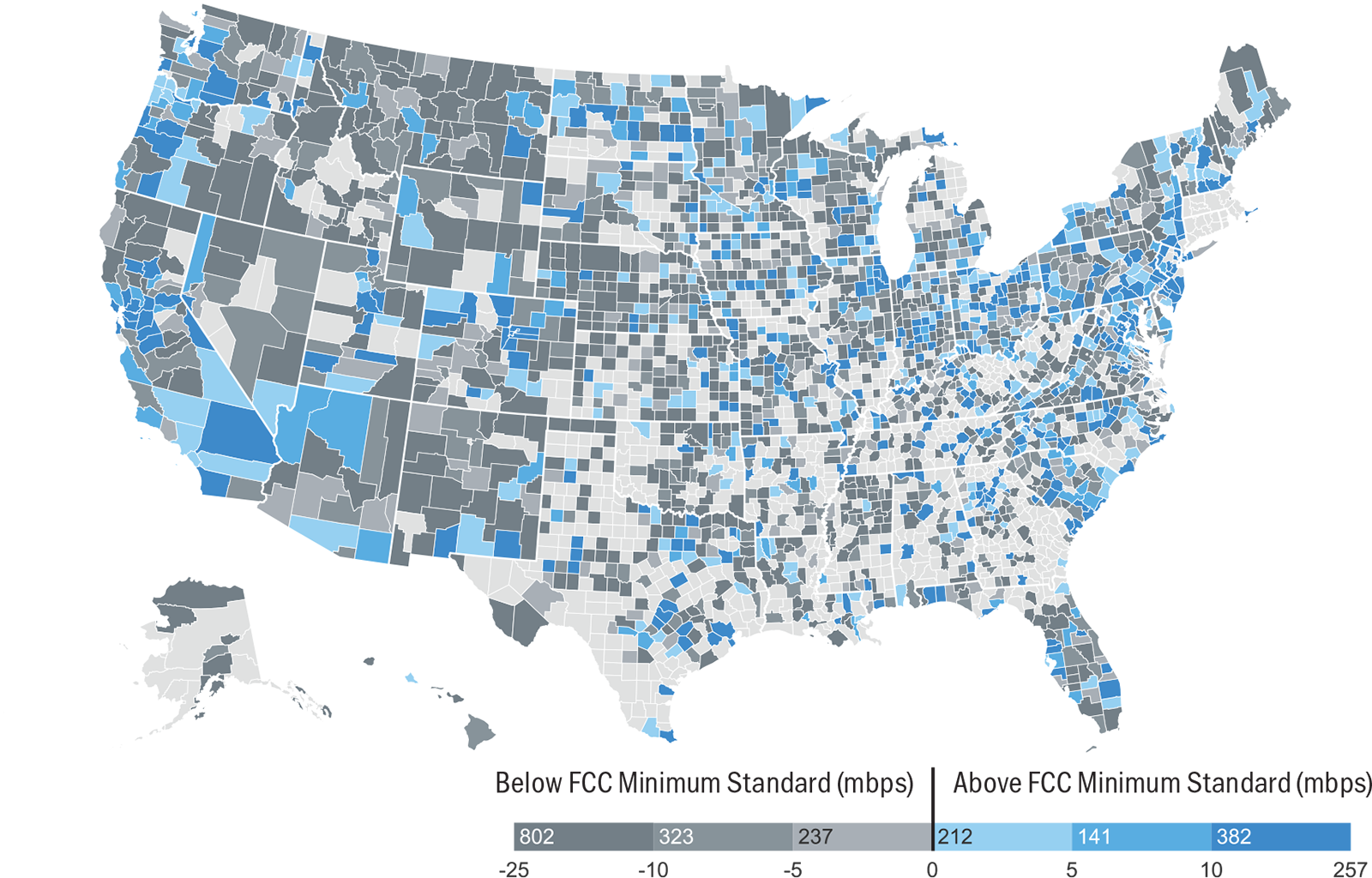
To help gain a broad understanding of connectivity in counties, this map combines cellular and fixed wireless results to calculate an average connectivity level. This map calculates the average download speed of TestIT observations for all counties with more than one onservation of either cellular or fixed-wireless connections. Averages ranged from 0.24 mbps (Cumberland County, Ky.) to a maximum average of 281.71 mbps (Lamar County, Miss.).
The FCC currently defines “broadband” levels at 25 mpbs download and 3 mbps upload. To help put connectivity into context, this map shows how counties are comparing to the FCC’s definition of a minimum standard of service. According to the tests collected, 1,362 counties are experiencing the internet at levels below the FCC’s definition of broadband including 19 percent of large counties, 51.5 percent of medium-sized counties and an alarming 77 percent of small counties.

County Average Cellular Download Speeds vs. FCC Minimum Standard
HIGH-SPEED CELLULAR SERVICE REMAINS A CHALLENGE FOR COUNTIES OF ALL SIZES
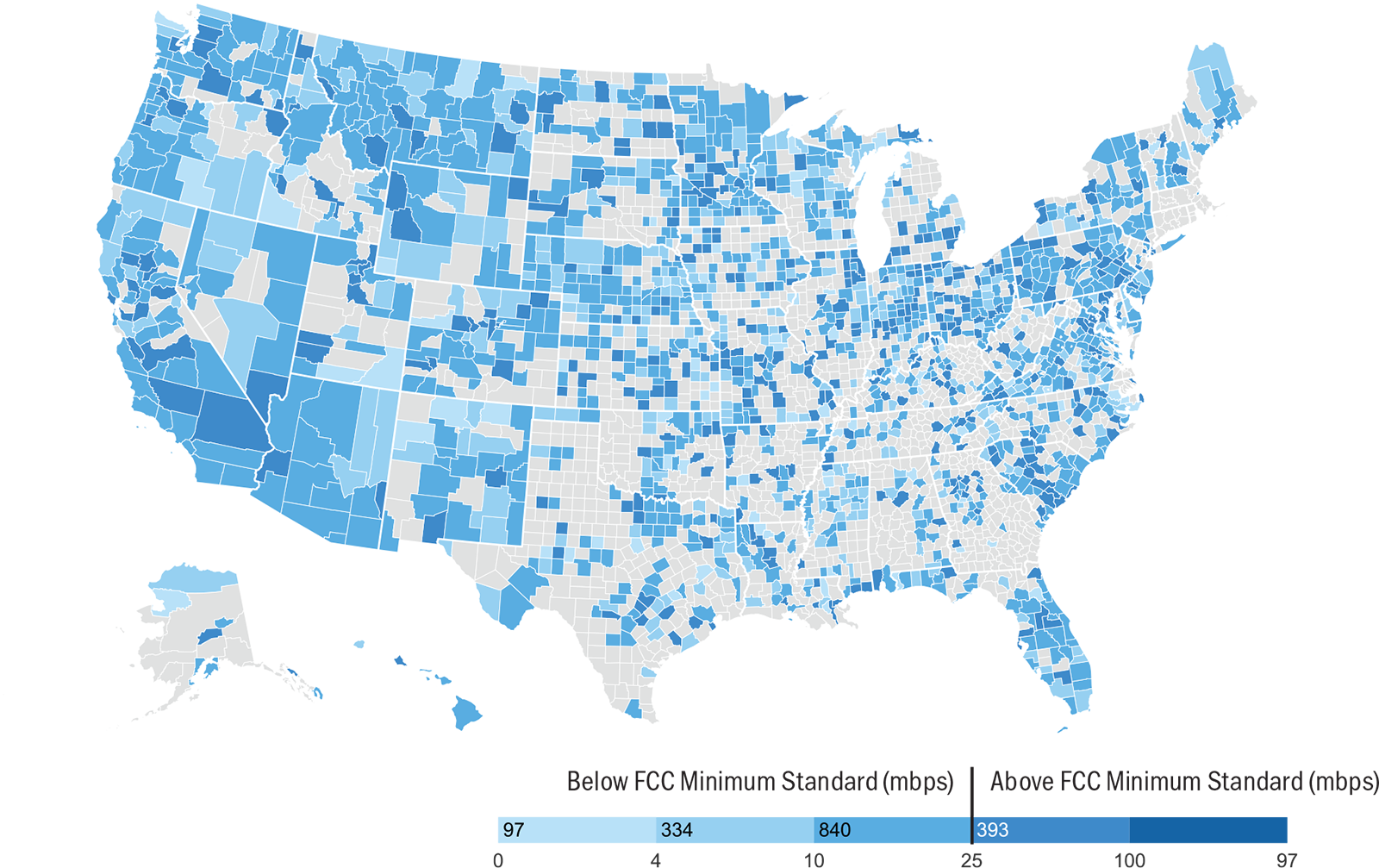
Due to topographic and density challenges, cellular service is often the only option for connectivity in extremely rural and remote counties. This map looks explicitly at cellular download speed averages for all counties with more than one test. The minimum average cellular download speed was 0.24 mbps (Cumberland County, Ky.) with a maximum county average of 96.72 mbps (Hays County, Texas).
In total, over 76 percent of counties were averaging cellular connections below the FCC’s minimum standard including 51.3 percent of large counties, 74 percent of medium-sized counties and 81 percent of small counties.
Large counties averaged 24.86 mbps for cellular download speeds while medium-sized counties averaged 18.28 mbps. Small counties saw a slight decrease in their average download speed of only 17.33 mbps.

County Average Fixed-Wireless Download Speed vs. FCC Minimum Standard
ROUGHLY 60 PERCENT OF COUNTIES ARE AVERAGING BELOW FEDERAL STANDARDS AT HOME AND WORK
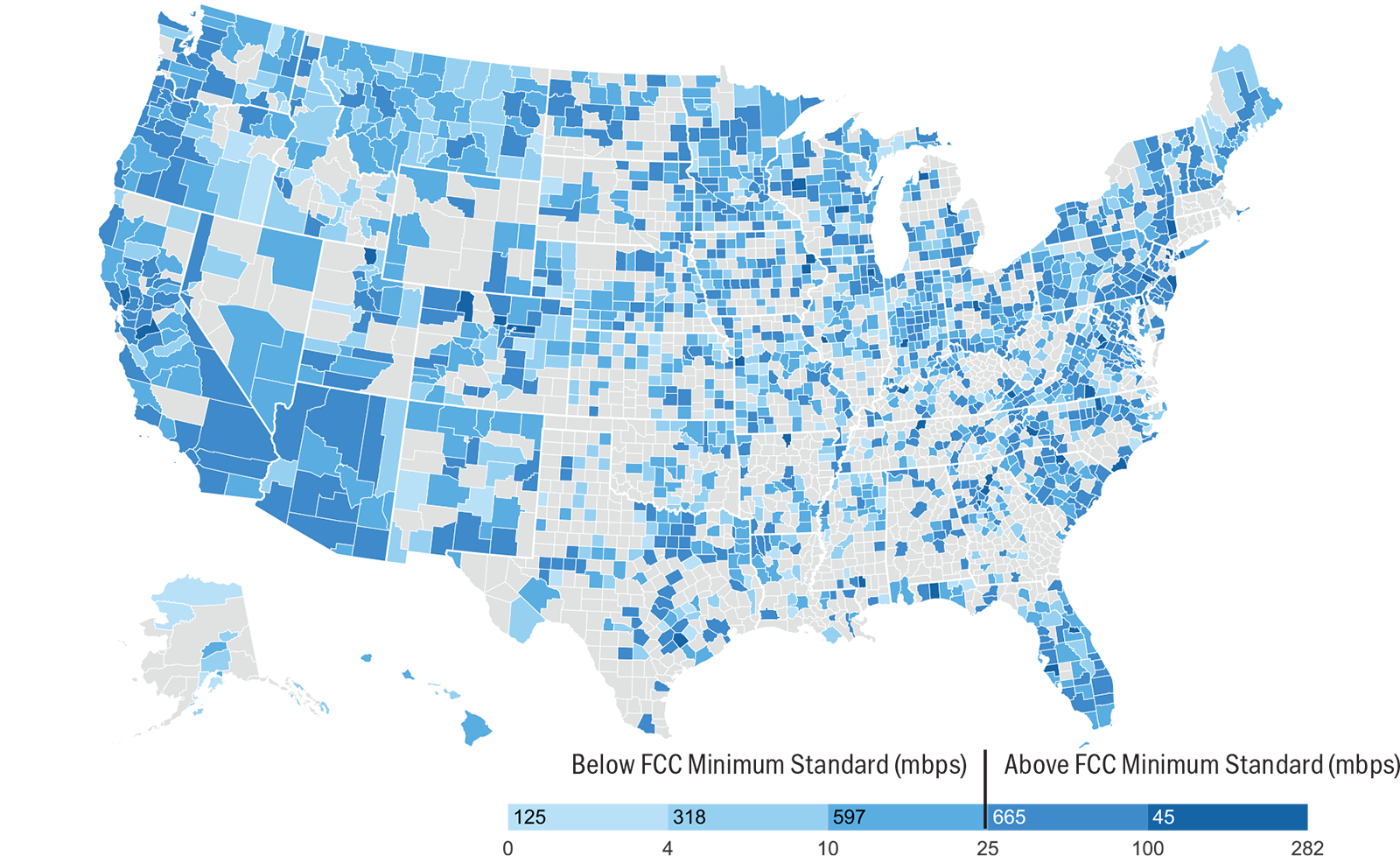
This map singles out fixed-wireless connection tests to look at how users are experiencing the internet via a home, work or public wi-fi connection. These results show an average minimum download speed of 0.15 mbps (Palo Pinto County, Texas) and an average maximum download speed of 281.71 mbps (Lamar County, Miss.).
In total, 59.6 percent of counties were experiencing fixed-wireless internet below 25 mbps including 16 percent of large counties, 44 percent of mid-sized counties and 74 percent of small counties.
On average, small counties were experiencing the internet from a wi-fi connection at 18.55 mbps – below the FCC’s definition of a minimum standard of broadband service. Large counties, however, were averaging 42.17 mbps while medium-sized counties were experiencing the internet at roughly 31.13 mbps.

County Average Fixed-Wireless Download Speed vs. Form 477 Data
WITH OVER 65 PERCENT OF COUNTIES EXPERIENCING THE INTERNET BELOW INDUSTRY-REPORTED LEVELS, OVER-REPORTING DISPROPORTIONATELY IMPACTS RURAL COUNTIES
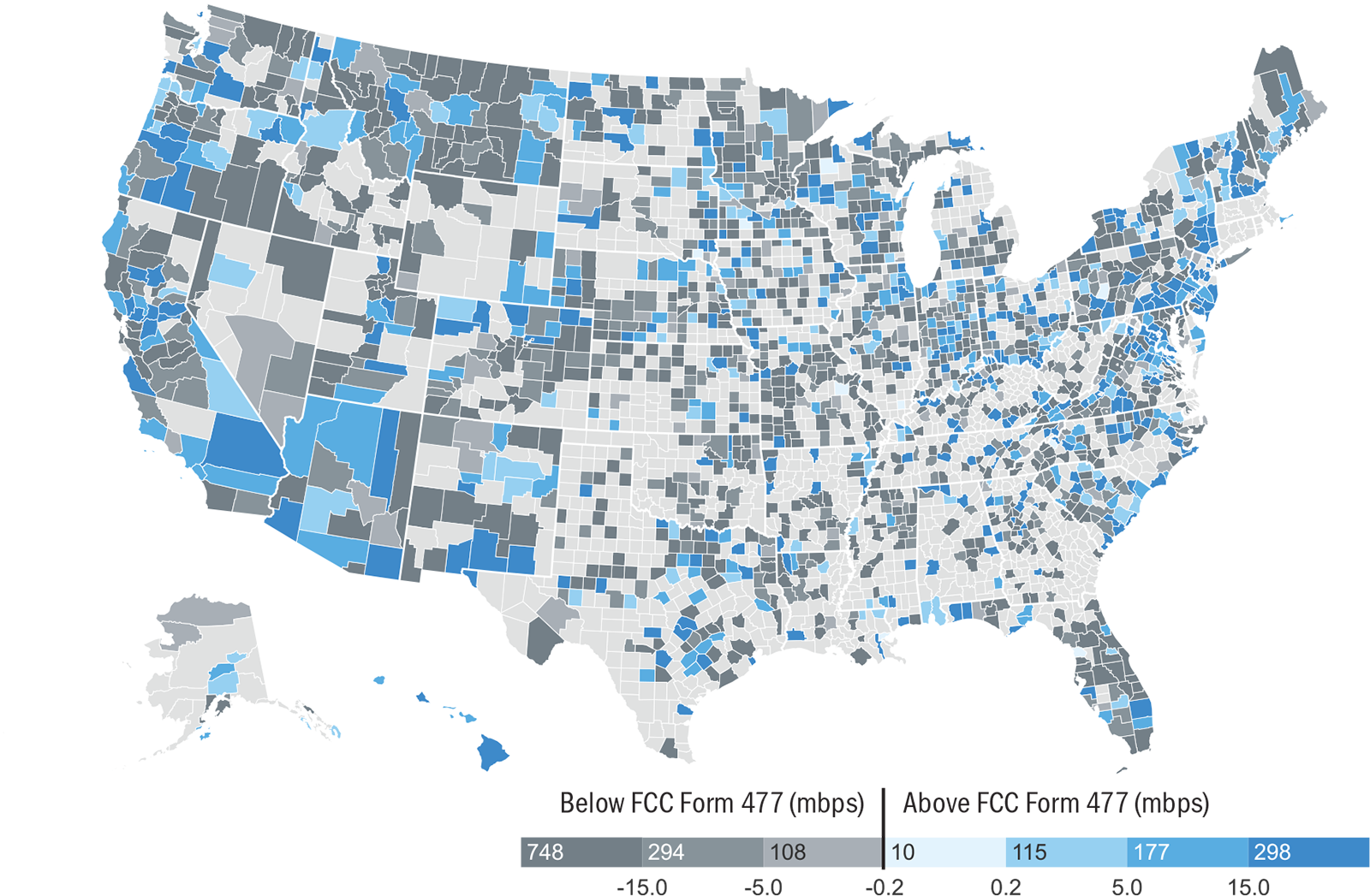
For this map, we look at how the county average for fixed-wireless service compares to the levels reported by the service providers through the FCC’s Form 477 process. For counties with more than one provider, this report uses the most frequently reported maximum speed from the service providers as the county’s Form 477 benchmark.
Based on current FCC reporting requirements, over 65 percent of counties were experiencing the internet at speeds slower than the levels reported by the industry. In total, the data shows significant levels of overreporting in counties of all sizes including 53.4 percent of large counties, 55.5 percent of medium-sized counties and an alarming 73.3 percent of small counties.

No Coverage Available Tests
ACCESS TO EVEN BASIC LEVELS OF CONNECTIVITY REMAINS A CHALLENGE IN MANY PLACES
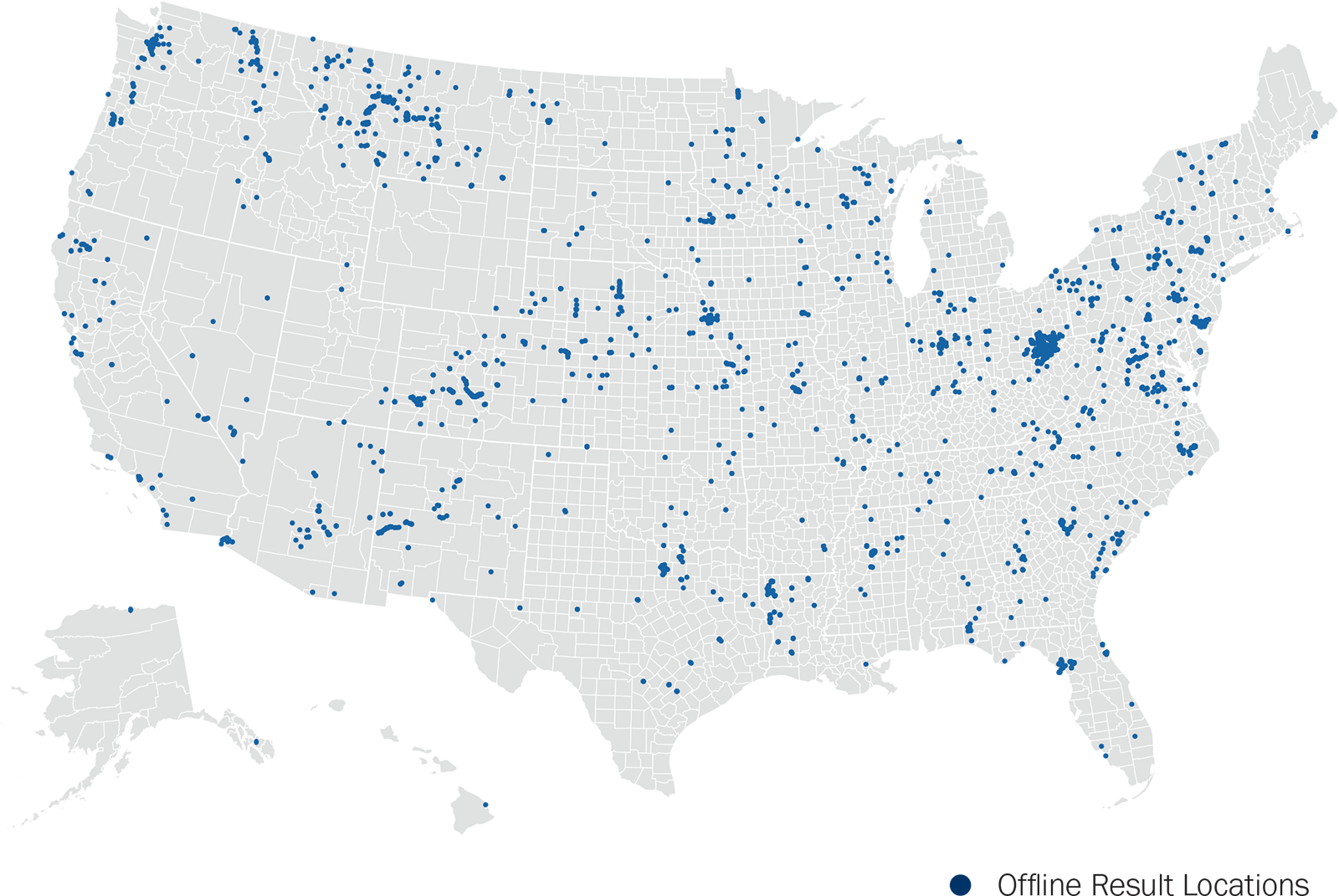
There are many factors contributing to a user’s connectivity level. As such, we encouraged users to test frequently and from both cellular and fixed-wireless connections. However, instances where neither option was available have been marked by the TestIT app. This map indicates locations where users did not have access to either connection.

|
Challenges and Opportunities to a Connected Community
Economic Development
The lack of broadband infrastructure in rural and other underserved communities has severely impaired the potential of communities to attract, retain and cultivate new businesses, especially industries dependent on electronic commerce. In today’s business environment, there are hardly any industries left that do not rely on the internet for sales, marketing, client management data analytics.
While the ability to recruit and retain new and emerging sectors to the local economy is important, fostering entrepreneurship and the growth of small businesses is just as important for rural communities. Small businesses help build economic resiliency in a community and e-commerce helps diversify entrepreneurs’ sales channels, making their companies more resilient.
Connectivity also enables communities to promote unique cultural and natural assets through tourism, creating new economic opportunities for a wide range of businesses. Social media has transformed tourism-based assets through free marketing, self-guided tours, digital trail maps and travel apps like Utah Heritage Walks, an app designed to attract new and existing audiences to culturally and historically significant attractions throughout the region.
Further, through co-working spaces or entrepreneur hub opportunities, expanded high-speed connectivity can help revitalize downtowns or other blighted communities by increasing foot traffic and sparking small business growth.
Education and Workforce Development
Access to the internet within the home has become a critical issue for both secondary and post-secondary education. A majority of teachers assign homework that requires a broadband connection and digital skills are quickly becoming a part of the new standard school curriculum. Online learning platforms and tools offer the opportunity to expand the array of topics, classes, certifications and degrees that students can pursue. However, connectivity challenges limit access to these opportunities and many students are facing the reality of falling behind their better connected domestic and global peers.
Today’s workforce also relies on internet access to identify and apply for new employment opportunities. According to data collected for the National Telecommunications and Information Administration (NTIA), “the number of Americans using the internet in their job search has steadily increased from 19 percent of internet users aged 15 and older in 2013 to 27 percent in 2015.” This trend has left many in underserved communities without work, as they lack the tools needed to access websites where jobs are posted.
Without access to affordable high-speed internet, workers in underserved economies are being left behind as employment opportunities are given only to those with access to information, education and training.
In addition to workforce recruitment, high-speed internet is being leveraged to train and certify labor for highly skilled positions. Online certifications and technical training are helping prepare labor pools in transitioning economies throughout the country. For example, welding certifications are utilizing virtual reality to help certify and train workers before being placed on a worksite. This level of training helps trim operational costs while ensuring the quality of work will meet industry standards.
Job opportunities and the needs of today’s workforce are also shifting with the advancement in technology. With the growth of the digital economy, an increasing number of jobs are being offered remotely in instances where employees have access to reliable and fast internet speeds. These remote employment opportunities are helping address the issue of rural migration by allowing individuals to earn competitive living wages without leaving their communities.
Unfortunately, far too many areas of America lack the level of connectivity required to provide such opportunities. Without access to affordable high-speed internet, workers in underserved economies are being left behind as employment opportunities are given only to those with access to information, education and training.
 |
Precision Agriculture
The agricultural industry has been the heartbeat of our nation for generations as farmers are responsible for providing the vast majority of our food, fuel and fiber. In many rural communities, agriculture still plays a significant role in the local economy. Unfortunately, it has become increasingly difficult for farmers to compete in the increasingly global agricultural economy. From rising input and labor costs, to intensifying global competition and adverse weather conditions, America’s farmers and ranchers need every tool available to stay competitive in today’s economy.
Without access to affordable broadband services, today’s farmers have struggled to utilize the technology available to them.
Precision agriculture allows farmers to leverage real-time data collected across a network of variables and sources to help make quick and informed decisions. It has allowed them to increase yields while decreasing marginal costs, in addition to improving agronomic and economic outcomes. From soil sensors and weather analytics to GPS-guided equipment and shipping and storage trackers, stakeholders throughout the agricultural supply chain can trim costs and bolster production by leveraging high-speed internet.
Without access to affordable broadband services, today’s farmers have struggled to utilize the technology available to them. A robust and resilient rural broadband network is imperative to ensure the agricultural industry can meet growing demands in the face of incredible adversity. Access to affordable broadband also will help attract other industries to rural communities, helping create jobs and improving quality of life.
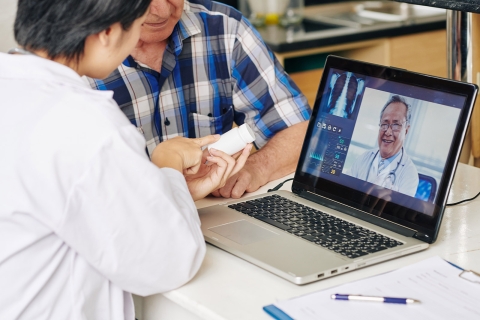
|
Health and Human Services
The role of high-speed internet permeates many aspects of our daily lives including access to critical healthcare services. Telehealth and remote diagnostic platforms are able to bridge the gap between remote communities and critical healthcare services. These tools not only help provide access to otherwise unattainable healthcare services for underserved communities, but also facilitate evidence-based decision making. Through high-speed internet, telemedicine applications enable real-time clinical care for geographically distant patients and providers.
In Coffee County, Ga. telehealth is being used as a cost-saving measure in the county’s school district. The program offers a comprehensive Adult & Pediatric Primary Care site located on all Coffee County school campuses. The site provides medical care services to students during the academic day. For example, a Bluetooth stethoscope is used on site to hear heart and lung sounds. The procedures are performed with the help of the school nurse and are analyzed by a remote physician, connected via web camera. The program also offers management and ongoing care of existing medical conditions, monthly medication maintenance, mental health, substance abuse and family-centered case management.
Through high-speed internet, telemedicine applications enable real-time clinical care for geographically distant patients
and providers.
The alarming rate of rural hospital closures has only elevated the urgency for access to remote diagnostics. Since 2010, 121 rural hospitals have closed their doors, with nearly 700 still at risk of closing across the country. This high number of closures has left residents in rural and remote communities reeling, as they often don’t have the luxury to travel the countless hours between home and healthcare services.
Additionally, many rural Americans rely on social supports such as the Supplemental Nutrition Assistance Program (SNAP). In fact, 14.6 percent of rural households rely on SNAP compared to only 10.9 percent of metropolitan households. Access to reliable internet is an important tool for these residents to apply for and access these resources. Without it, residents living below the poverty line — who often lack transportation, childcare and time — are faced with considerable barriers for access to these critical services.
The Opioid Epidemic
Broadband services play a significant role in addressing the opioid epidemic. Rural America has been disproportionately impacted by this epidemic largely due to the demands of physical labor on the rural workforce in an area absent of critical health resources. Between 1999 and 2015, drug overdose deaths in rural counties jumped by 325 percent as compared to 198 percent in metropolitan areas. Telehealth provides rural communities with the ability to quickly diagnose, treat and monitor the progress of patients while removing much of the stigma associated with seeking treatment for substance abuse issues.
Emerging technologies used by law enforcement to communicate about opioid-related overdoses or drug trafficking are unattainable without access to broadband services. Many communities are implementing programs like ODMAP. This web-based application, hosted by the U.S. Office of National Drug Control Policy, helps connect law enforcement with public health departments in real-time to identify areas where high numbers of opioid-related overdoses are occurring to help them respond effectively.
Additionally, treatment for opioid addictions often require patients to travel long distances each day for medication-assisted treatment. “Although there is a shortage of opioid treatment programs nationwide, the gap is most significant in rural areas, where 88.6 percent of rural counties lack a sufficient number.” Remote diagnostics and monitoring programs can help bring these critical services to the patients — eliminating many of the barriers to treatment as well as addressing the stigma associated with seeking help.
Justice and Public Safety
Communities are leveraging high-speed internet to provide telehealth programs and other services for inmate populations that not only cut costs, but also addresses significant security concerns associated with moving inmates to and from jails. From prescription drugs, daily nursing evaluations and treatments to remote arraignment and sentencing platforms, broadband plays a critical component in alleviating the many pressures on our nation’s criminal justice system.
Law enforcement officers also rely on broadband services while in the field. For example, one community in Springfield, Mo., uses telehealth technology to connect law enforcement officers to mental health clinicians when responding to calls for services involving people experiencing a crisis. In this situation, the officer may reach an on-call clinician over a tablet to receive guidance on how to proceed and the individual being served is connected virtually with the clinician face-to-face, resulting in de-escalation of the crisis and connections to follow-up appointments and treatment.
Access to affordable high-speed internet has the ability to ease the fiscal and operational strain on our nation’s public safety systems.
Major upgrades are underway to improve emergency communication through Next Generation 911 (NG911) and the development of a public safety broadband network by the First Responder Network Authority (FirstNet). FirstNet offers a digital communication tool for first responder teams to communicate with one another in the field and receive important information from 911 call centers. In cases of mass casualty incidents or natural disasters, when the closest public safety answering point (PSAP) becomes overwhelmed by calls, an IP-based NG911 system will allow for the automated transfer and processing of calls at another available PSAP.
The fiscal and operational strain on our nation’s public safety systems are at an all-time high. Access to affordable high-speed internet has the ability to ease this pressure by creating efficiencies in the system while improving overall safety and welfare.
 |
Summary
Through the TestIT app, we demonstrated that small counties are disproportionately impacted by the digital divide. With regards to fixed-wireless levels, 59.6 percent of counties were experiencing the internet below 25 mbps including 16 percent of large counties, 44 percent of mid-sized counties and 74 percent of small counties. Regardless of size and demographics, all counties and communities across America should have access to affordable, reliable and high-speed Internet.
Additionally, over 65 percent of counties were experiencing the internet at speeds slower than the levels reported by the industry including 53.4 percent of large counties, 55.5 percent of medium-sized counties and an alarming 73.3 percent of small counties.
According to the test results, cellular connectivity also remains a considerable challenge for counties of all sizes. Large counties averaged 24.86 mbps for cellular download speeds while medium-sized counties averaged 18.28 mbps and only 17.33 mbps for small counties.
These gaps in our nation’s broadband coverage exist for many reasons, including:
- Incomplete and Inaccurate Data: To effectively build our nation’s broadband network, all stakeholders must first rely on accurate and complete connectivity data as a foundation for resource allocation. Without it, we run the risk of overlooking major gaps in our nation’s broadband coverage and leaving entire communities and populations behind.
- Prohibiting Local Solutions: Unfortunately, many counties are often prohibited by states from making initial investments in infrastructure to help attract service providers to an unserved area. In fact, 25 states have placed certain limitations or outright bans on municipally-owned broadband networks. By removing local governments from the solution, these states have effectively created an unsolvable equation. States should empower local governments to leverage public and private investments towards bridging the digital divide.
- High Cost of Deployment: Broadband networks are dynamic infrastructure, subject to frequent technological advances that require upgrades and capital spending. Providing a cost-recovery or an incentive-based mechanism to connect all Americans is not a new concept. This same approach was key to building out other essential utilities, such as water, electricity and telephone service, in underserved areas.
For any community, the lack of a scalable market — real or perceived — often prevents the industry from investing in broadband infrastructure. Without substantive changes to the data collection process, removal of local barriers and the reclassification of broadband as a utility — no less important than water and electricity — the digital divide will only continue to grow.
Municipal Broadband Roadblocks
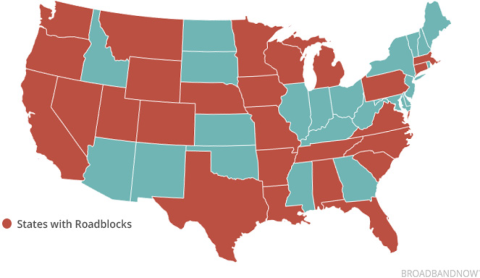
Source: https://broadbandnow.com/report/municipal-broadband-roadblocks/
Endnotes
- https://us-fcc.app.box.com/v/Form477Instructions
- www.statista.com/statistics/241462/global-mobile-phone-website-traffic-share/
- www.ntia.doc.gov/blog/2016/access-broadband-fuels-workforce-development-and-enhances-job-skills
- www.naco.org/blog/telehealth-snapshot-county-practices
- www.ruralhealthweb.org/about-nrha/about-rural-health-care#_ftn1
- www.cdc.gov/mmwr/volumes/66/ss/ss6619a1.htm
- www.naco.org/sites/default/files/documents/Opioids-Full.pdf
- www.addictioncenter.com/news/2019/10/opioid-treatment-rural-addiction/
- www.kspr.com/content/news/Springfield-Police-Officers-use-Burrell-Behavioral-Healths-mobile-counseling-in-the-field-499623391.html
- www.911.gov/pdf/NASNA_National_911_Program_NG911_FirstNet_Guide_State_Local_Authorities.pdf
- https://broadbandnow.com/report/municipal-broadband-roadblocks/